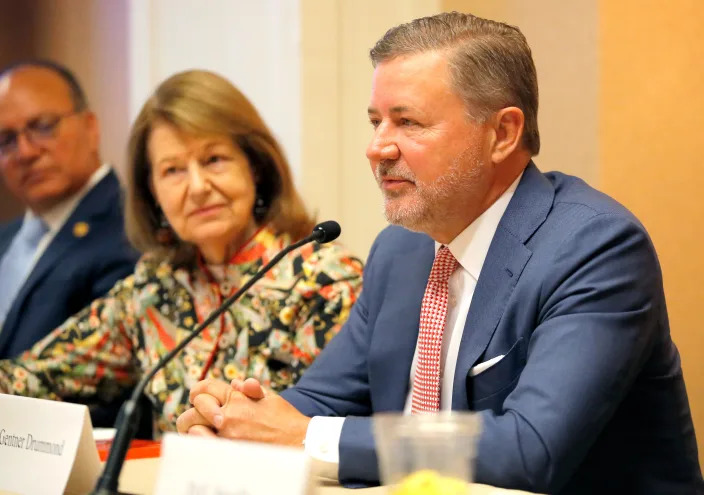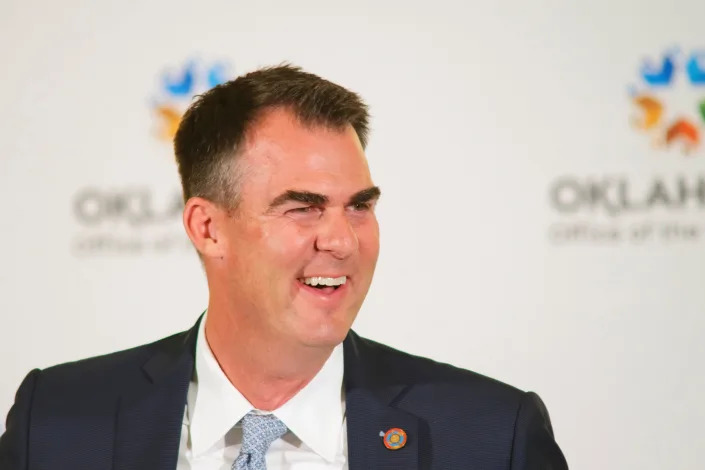
Woman in office looking at robotic arm
The UK is falling behind in protecting workers from artificial intelligence (AI), a trade union has warned.
The TUC said the UK had no plans, like the EU's AI Act, to regulate its use in hiring, firing and setting work conditions. The union has asked a taskforce to draft legal protections.
The government said it was committed to improving and upholding worker rights.
It comes as the boss of Octopus Energy told the BBC its customers prefer emails written by AI over his staff.
Business leaders are hailing the potential of AI to spur innovation, productivity and improve customer service.
But unions say they are "deeply worried" that UK employment law is not keeping pace with the AI revolution.

Mary Towers at the TUC said it had launched a taskforce to draft its own AI legal protections
Mary Towers, employment rights policy officer at the TUC said: "The types of decisions that are being made by AI are significant and life changing - for example who should get a job, how work is carried out where it's carried out."
A lack of AI specific legislation meant the UK was being left behind, she said. "For example, in the EU, they are in the process of passing an AI Act. In this country, we don't have any equivalent."
'Prefer AI to humans'
At Octopus Energy, AI is used to read, interpret and answer customer service queries. Chief executive Greg Jackson said it was doing work that would otherwise need an extra 250 people.
He said customers appeared to prefer dealing with the AI than with a human.
"An email written by our team members has a 65% satisfaction rating from customers," he said. "An email written by a by AI has an 80 or 85% satisfaction rating. And so what the AI is doing is enabling our team to do a better job of serving customers at a time of great need."

Octopus Energy boss Greg Jackson said emails written by AI score higher for customer satisfaction than those written by humans
He added that a human commanding an AI to write an email "saves a lot of tedious typing".
"But we have to ensure this is all done responsibly. And we need governments and economists and businesses to be ensuring that we're doing this by enhancing and creating jobs, not replacing them."
'Better health outcomes'
AI could lead to huge breakthroughs in science and medicine according to the boss of drug giant GSK. Emma Walmsley told the BBC that the speed with which AI could process data and see patterns would revolutionise drug development.
"Biopharma is difficult. It takes sometimes a decade, billions, and it has a 90% failure rate," she said.
"But we are in the business of data at the heart of what we do. AI is helping us see things in this data faster."
She said this meant drug and vaccine discovery and development should become "more predictive and improve our probability of success".
And she said that could mean better health outcomes for hundreds of millions of people.
"One in three of us is going to be battling with dementia, there are still many cancers that don't have have solutions, infectious diseases are still causing one in six deaths in the world," she said.
 Emma Walmsley at GSK said AI could help bring better health outcomes for millions
Emma Walmsley at GSK said AI could help bring better health outcomes for millionsThere was "no doubt" that AI would "help us unlock better solutions to these challenges", she said. "And that's got to be something worth investing in with optimism whilst regulating responsibly."
Ms Walmsley thinks improving productivity through the use of AI will create more jobs and "change some jobs quite meaningfully".
"I think some will need maybe some less headcount on but there'll be other spaces where we need a lot more," she said.
 Voice artist Laurence Bouvard said AI was destroying careers
Voice artist Laurence Bouvard said AI was destroying careersIt is sometimes assumed that the creative arts will be the least affected by AI as machine learning will struggle to replicate human creativity.
But that's wrong according to actress and voice over artist Laurence Bouvard who said that AI is being used to sample, analyse and replicate human voices without paying the original artist.
"When we do a job, in order to get paid, we have to sign away all our rights," she said. "And these AI companies are just taking it without asking who it belongs to."
She said AI was a particular threat to the "army" of lesser known artists who voice cartoons, video games, dictionaries and other audio work who could see their careers totally destroyed.
"A writer and an artist and a photographer, even if their work is stolen, they can create new work. If my voice is stolen, if my career is over," she said.
'Urgent action'
AI has great power and is already changing industries and the work place. Last week the OECD said the world was "on the cusp of an AI revolution".
The Paris-based body said: "Urgent action is required to make sure AI is used responsibly and in a trustworthy way in the workplace."
With great power comes great responsibility - and it is not yet clear in the UK or internationally - who will or who should take on that responsibility.
A government spokesperson said: "AI is set to fuel growth and create new highly-paid jobs throughout the UK, while allowing us to carry out our existing jobs more efficiently and safely.
"That is why we are working with businesses and regulators to ensure AI is used safely and responsibility in business settings."
Tech-savvy UK businesses to invest in AI to replace staff and cut costs – HSBC
Anna Wise, PA Business Reporter
Wed, July 19, 2023
Nearly a third of UK businesses which are focused on becoming more tech-savvy want to use artificial intelligence (AI) and automation to bolster their workforce and replace staff, a survey has found.
A majority of firms are targeting technology to further their growth plans, but smaller businesses who have conflicting priorities are at risk of being left behind in the race to automate, according to a survey by banking giant HSBC UK.
Some 45% of all businesses surveyed said technology was an important area of strategic focus, and a quarter planned to invest in AI and machine learning to boost efficiencies and tackle staffing and cost challenges.
British businesses are looking to better use technology to cut costs, as firms have been hit by worsening economic conditions, HSBC found in its latest survey of 500 firms.
Some 30% of businesses which are focusing on technology said they want to use automation as a labour solution. The proportion jumps to nearly half of companies who are laser-focused on growth.
It comes as more than one million job vacancies were recorded in the latest quarter, according to the Office for National Statistics. Vacancies spiked following the pandemic, driven by a rise in older workers leaving the labour market.
But job postings have been steadily dropping as companies are coming under continued cost pressures, leading recruitment activity to slow.
More than 60% of companies prioritising tech development want to use it to improve experiences for customers, the report revealed.
It comes after telecoms giant BT announced it will be shedding about 10,000 jobs by the end of the decade as it digitises and relies more on automation.
In particular, it wants customers to use its website and app for things like account servicing and upgrades, rather than relying on call centres.

BT said it wants to replace about 10,000 jobs with AI and automated services by the end of the decade (BT/PA)
However, HSBC’s survey revealed that some smaller businesses feel tech innovations are out of reach for them, while large corporations have more access to AI and automation capabilities.
Some 38% of small firms said they lacked optimism about the year ahead and were instead focused on staying afloat.
Stuart Tait, the head of UK commercial banking at HSBC, said: “We have seen a huge rise in the number of ambitious and innovative businesses keen to unlock the potential that technology can bring.
“While technology is not a cure all, it is an enabler to success; it is cause for concern that smaller businesses are struggling to engage and risk being left behind.”
Meanwhile, Hollywood actors have joined picket lines in the US amid the biggest industry strike in 60 years, with unions protesting against decisions by major studios that could see AI tools replace their roles.
Screenwriters are also striking amid fears that AI could be used to write or edit scripts.
UKGovernment aims to boost AI skills with experts from private tech firms
Christopher McKeon, PA Political Reporter
Wed, July 19, 2023
The Government could pay the salaries of hundreds of private sector digital experts as it tries to improve its use of artificial intelligence (AI) and data, a minister has said.
Cabinet Office minister Jeremy Quin said the Government would parachute experts from tech companies into Whitehall departments in a new secondment scheme designed to make the Civil Service more efficient.
In a speech at the Policy Exchange think tank on Wednesday, Mr Quin said: “I know that there are people from the best tech firms in the country who believe in public service, who want to help with the biggest challenges facing society today.

Cabinet Office minister Jeremy Quin said the new secondment scheme is designed to make the Civil Service more efficient (Richard Townshend/UK Parliament/PA)
“So we will create a pathway for them to join the Civil Service through a secondment and empower them to drive real, tangible change.
“We must attract and retain the best in digital talent so we can harness the power of digital, data and technology to deliver most efficiently and effectively for the public.”
Asked how the Civil Service would attract staff from tech firms, given the disparity in pay between the public and private sectors, Mr Quin said there is scope to be “flexible”, with secondees remaining on their companies’ payrolls and having their salaries recharged to the Government.
He added: “I know we’ve got a lot of good colleagues, I know a lot have come from the private sector, but this is such a fast-moving world, to have the experience of people coming in with fresh ideas straight from the private sector on a secondment basis, I think that has more to add.”
Existing civil servants could also see their pay increased if they can demonstrate particular skills.
Mr Quin said: “I’ve got no problem with paying civil servants more for being more productive.”
During his speech, the minister announced a series of other measures to improve the efficiency of the Civil Service and its digital capabilities, including using AI “confidently and responsibly”.
But he could not say how many jobs he expects to be cut from the Civil Service through greater use of AI and automation.
He said: “The jury is completely out. What we know is that AI will have a revolutionary impact on a whole range of sectors right the way across the economy, but that doesn’t necessarily mean you can draw an analogy in terms of ‘that means we need to have x thousand fewer people by a certain date’.”
Last month, the former head of human resources for the Civil Service told MPs that AI could see two-thirds of Whitehall jobs under threat.
Artificial intelligence: Experts propose guidelines for safe systems
Zoe Kleinman - Technology editorBBC
Wed, July 19, 2023

Automatic image tagging uses machine learning technology to identify the contents of an image
A global group of AI experts and data scientists has released a new voluntary framework for developing artificial intelligence products safely.
The World Ethical Data Foundation has 25,000 members including staff working at various tech giants such as Meta, Google and Samsung.
The framework contains a checklist of 84 questions for developers to consider at the start of an AI project.
The Foundation is also inviting the public to submit their own questions.
It says they will all be considered at its next annual conference.
The framework has been released in the form of an open letter, seemingly the preferred format of the AI community. It has hundreds of signatories.
AI lets a computer act and respond almost as if it were human.
Computers can be fed huge amounts of information and trained to identify the patterns in it, in order to make predictions, solve problems, and even learn from their own mistakes.
As well as data, AI relies on algorithms - lists of rules which must be followed in the correct order to complete a task.
What is AI, is it dangerous and what jobs are at risk?
The Foundation was launched in 2018 and is a non-profit global group bringing together people working in tech and academia to look at the development of new technologies.
Its questions for developers include how they will prevent an AI product from incorporating bias, and how they would deal with a situation in which the result generated by a tool results in law-breaking.
This week shadow home secretary Yvette Cooper said that the Labour Party would criminalise those who deliberately use AI tools for terrorist purposes.
Prime Minister Rishi Sunak has appointed Ian Hogarth, a tech entrepreneur and AI investor to lead an AI taskforce. Mr Hogarth told me this week he wanted "to better understand the risks associated with these frontier AI systems" and hold the companies who develop them accountable.
Other considerations in the framework include the data protection laws of various territories, whether it is clear to a user that they are interacting with AI, and whether human workers who input or tag data used to train the product were treated fairly.
The full list is divided into three chapters: questions for individual developers, questions for a team to consider together, and questions for people testing the product.
Some of the 84 questions are as follows:
Do I feel rushed or pressured to input data from questionable sources?
Is the team of people who are working on selecting the training data from a diverse set of backgrounds and experiences to help reduce the bias in the data selection?
What is the intended use of the model once it is trained?
"We're in this kind of wild west stage"
"We're in this Wild West stage, where it's just kind of: 'Chuck it out in the open and see how it goes'." said Vince Lynch, founder of the firm IV.AI and advisor to the World Ethical Data Foundation board. He came up with the idea for the framework.
"And now those cracks that are in the foundations are becoming more apparent, as people are having conversations about intellectual property, how human rights are considered in relation to AI and what they're doing."
If, for example, a model has been trained using some data that is copyright protected, it's not an option to just strip it out - the entire model may have to be trained again.
"That can cost hundreds of millions of dollars sometimes. It is incredibly expensive to get it wrong," Mr Lynch said.
Other voluntary frameworks for the safe development of AI have been proposed.
Margarethe Vestager, the EU's Competition Commissioner, is spearheading EU efforts to create a voluntary code of conduct with the US government, which would see companies using or developing AI sign up to a set of standards that are not legally binding.
Willo is a Glasgow-based recruitment platform which has recently launched an AI tool to go with its service.
The firm said it took three years to collect sufficient data to build it.
Co-founder Andrew Wood said at one point the firm chose to pause its development in response to ethical concerns raised by its customers.
"We're not using our AI capabilities to do any decision making. The decision making is solely left with the employer," he said.
"There are certain areas where AI is really applicable, for example, scheduling interviews... but making the decision on whether to move forward [with hiring a candidate] or not, that's always going to be left to the human as far as we're concerned."
Co-founder Euan Cameron said that transparency to users was for him an important section of the Foundation framework.
"If anyone's using AI, you can't sneak it through the backdoor and pretend it was a human who created that content," he said.
"It needs to be clear it was done by AI technology. That really stood out to me."
Follow Zoe Kleinman on Twitter @zsk. 




























